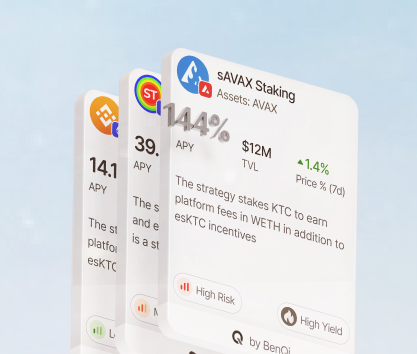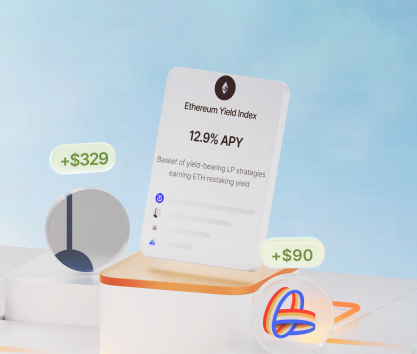Many investors without any prior exposure to financial markets do not understand what APY means and how it differs from APR. A lot of people simply think that the percentage is the potential profit in absolute terms. However, there is a difference between interest rate, APR, APY, and profitability. Understanding what these terms mean and how to estimate future gains or losses based on these numbers is hugely important for any contemporary investor.
Note that the DeFi sector has many protocols that use floating or flexible APRs meaning that rates vary depending on market circumstances and other factors like utilization, available liquidity in the pool, and even transaction costs. Unfortunately, many of these factors are unpredictable making it challenging for investors to make good estimations for future profits. Nevertheless, it is possible to make solid forecasts through first-hand experience or very conservative approaches to estimating profitability.
What is APY in yield farming?
APY stands for Annual Percentage Yield while APR means Annual Percentage Rate. In tradfi, you will often hear that APR is the interest rate on borrowed funds while APY is what you will earn on invested capital. While it is true in the DeFi sector when it comes to lending protocols, many use these terms slightly differently:
- APR means the flat interest rate paid on an investment without compounding. Usually, rewards and yields are paid daily based on the annualized rate. However, reinvestments are not accounted for.
- APY is the total yield on investments with all compounding (usually, daily) taken into consideration. That is why you will often see only APR values on Dapps and APY values on aggregators and trackers.
This particular difference is meaningful to a particular degree. Compounding does make a difference over long periods, but it won’t make a dent in overall profitability without just six months especially if you don’t have a monstrously huge portfolio. On the other hand, when it comes to yield farming, it is a good idea to consider compounding since reward tokens may increase in price by the time of your exit making even small increases in yields substantial.
Let’s take a look at an example of two investments with daily compounding and without:
- An investor puts in $1000 in a pool with a 5% APR without compounding. After a year, they receive $50.
- The second investor puts in $1000 in a pool with a 5% APR compounded daily. In a year, they will see a 5.17% return or $51.27.
The difference between these two examples is just $1.27 or 2.54%. Over longer periods, the difference will be more pronounced. For instance, you will receive only $500 on the same investment after 10 years without compounding and $647 with compounding. The gap grew to 29.4% which is significant.
In yield farming scenarios, you are paid in native or governance tokens with prices fluctuating significantly. The market volatility must be taken into consideration in cases when you are putting in stablecoins or mainstream tokens like Bitcoin or Ethereum which are less volatile compared to many other coins.
How to calculate APY
Let’s take the same example and apply imaginary price fluctuations to them. It is a good way to illustrate how APY can be a very weird metric depending on the market circumstances. The issue here is that reward APYs are often calculated based on the value of staked assets. For instance, if you invest $1000 worth of ETH in a pool that rewards you with ARB, you will be receiving gains in ARB tokens with value corresponding to the underlying asset.
The APY will vary depending on the relative value of assets. If the ARB’s price falls against ETH, the yield may increase. At the same time, you have to remember things like an impermanent loss when the price of the staked asset falls dramatically which is an issue for many two-sided pools with some memecoins paired with stablecoins or mainstream coins like BTC or ETH.
Let’s get back to discussing examples:
- If you invest $1000 worth of ETH in a one-sided pool for rewards in ARB, you may receive 5% APY when the price of the reward token is stable.
- If the price of the reward token goes up by 10%, the APY may be adjusted to 4.5% to compensate for the discrepancy in asset prices.
- On the contrary, when the price of the reward token dips by 10%, you may receive an increased yield of 5.5%.
If the protocol employs this type of dynamic APR adjustment, it is normal to see incredibly high APYs in rewards or cheaper assets in the pair. In our case, you will benefit from receiving a higher yield if the price of the reward token goes up when you plan to exit and liquidate a position.
APY calculation
The formula for the annual percentage yield is quite simple. If you are an old-school person who does not like using calculators, you can simply use this formula:
(1+R/N)*N – 1,
where R is the period during which you are receiving interest and N is the number of compoundings. R is your APR.
Note that calculating APYs is not always the best way of estimating potential yields since different protocols may use different ways of determining APRs dynamically. Reviewing smart contracts issued by the projects and meticulously researching pool settings should be your top priorities. In many cases, you won’t be able to get a good picture of future gains without any first-hand experience.
Exploring Factors Affecting APY
You might have noticed that protocols have different APYs on similar pools. The most important factor that affects APYs on a platform is the level of competition for investor funds. Decentralized exchanges are always competing for liquidity and must offer lucrative interest rates to attract users. One of the best examples is DeDust, a DEX platform on The Open Network blockchain. DeDust offers up to 25% in TON rewards to investors who are ready to invest in stablecoins.
Here are some other important factors:
- Asset prices. As previously discussed, fluctuations in the market can dramatically affect potential yields. When it comes to staking for regular rewards, you will be always at risk of impermanent loss due to unpredictable price movements. This volatility is the reason why many investors choose stablecoins like DAI or USDC. For instance, MakerDAO offers a consistent 6% APY on DAI stakes.
- The impact of liquidity on APY. Available liquidity and asset utilization also play a huge role. Again, it depends on smart contract designs. In some cases, you will be receiving higher APYs when liquidity drops since the protocol will incentivize investors to keep their assets staked. Some smart contracts are designed to lower interest rates when utilization or liquidity falls noticeably.
- Reward token type. Memecoins can have exorbitant APRs simply because their prices are at rock bottom right after the initial spike in value. ORCA on Solana offers 12,773% on the SOL-HMSTR pool with the overwhelming majority of gains paid in the Hamster token. The STLOS-USDC pool on the ApeSwap AMM offers 4,681% in native tokens. On the other hand, investing in the WETH-WBTC pool on PanCakeSwap on the Linea chain will yield just 7.5% in CAKE rewards.
Fees and commissions in yield farming
When trying to calculate the potential profitability of investments in the yield farming sector, you have to take into consideration a variety of factors including all and any payments that you have to make to keep investments active.
Here are some of the investment costs that must be accounted for:
- Borrow APRs if you are using leveraged yield farming instruments or take out loans to receive yields. If you use liquid staking platforms like MakerDAO or LIDO, you can use staked tokens as collateral to borrow assets that can be further staked for yield farming. For instance, stETH can be used to borrow USDC which can be used on a plethora of different protocols to receive rewards. In such cases, you simply subtract the borrow APR from the overall APR you are planning to gain.
- Fees and commissions. You must review smart contracts to learn how pools operate and which swapping routes they use to make adjustments in asset compositions. In some cases, Ethereum-based pools use roll-ups to reduce transaction prices and make adjustments in asset ratios cheaply. In other cases, you will be subjected to gas fees when liquidating a position. Accounting for fees and commissions when trying to estimate potential profits is hugely important.
- Subscriptions or protocol commissions. Some platforms may take a cut of the cash flow to fund their operations. In other cases, tokenomics in farms (often, in degen farms) are set up in a way that benefits only founders and first buyers. The latter is not a method of actively gathering commissions on user operations but the outcome is essentially the same: you are investing more to receive the same level of returns as those who did not invest a dime.
Yield farming strategies for higher APYs
An investor can engage in a variety of techniques to amplify their gains. We strongly encourage readers to do their own research when it comes to high-risk investments. All yield farming strategies come with significant risks.
Here are some interesting approaches that you may find interesting:
- Liquid staking for higher overall earnings. You can stake ETH on LIDO for 2.66% APY and use stETH as collateral to borrow USDC on Aave. Stablecoins can be staked in the two-sided pool WETH-USDC on Aerodrome (Base) for up to 10% in AERO rewards. This scheme works well for people who are interested in keeping their Ethereum holdings staked while continuing investing in the DeFi sector. Note that moving stablecoins from one chain to another is an additional risk and can be quite costly.
- Going after conservative yield farming returns. If you are not particularly interested in exposing your portfolio to additional risks, you can invest in time-tested protocols which usually work with established projects and offer lower yields on average. For example, you can use Convex Finance and its CVXCRV pool with a $95 million TVL to receive up to 12.25% in CVX/CVR rewards. Alternatively, staking in the WETH-WBTC pool on PanCakeSwap gives you over 7.8% in CAKE rewards.
- Timing your exit in risky projects. Even degen farms can be a profitable investment if you manage to time your exit just right and liquidate a position before the inevitable market crash. All native tokens eventually lose their value due to inflation. Again, you can try to liquidate holdings before it happens. It takes experience and intuition to consistently earn money on protocols that either flood the market with native tokens or operate as Ponzi schemes.
Contemporary DeFi investors can invest in a wide range of different protocols that offer native or governance tokens as rewards. We do not endorse any of the projects below but we definitely have faith in them as they are time-tested platforms chosen by millions of investors from all over the world.
- Convex Finance is a part of the Curve DEX ecosystem and offers automatic market-making and various trading instruments. The variety of pools here is not as impressive as on some other platforms but you can easily find a suitable option. For instance, stablecoin holders can invest in the USDC-CRVUSD pool for 0.22% APY and 6.19% in CRV/CVX rewards. If you want to go all-in on the platform, investing in the CVXCRV pool 12.25% in rewards can be a good idea.
- Aerodrome on the Base chain is a great destination for investors interested in highly profitable yield farming. Whether to work with this protocol depends wholly on your faith in the Aero token which has been performing quite well recently. It is still 584% up over eight months after launching. The OVN-USD+ pool yields 168% APY in AERO rewards. The TVL of the pool is over $34 million and growing.
- Merkl on Arbitrum is also an interesting choice for investors interested in flexible yield farming opportunities. All rewards here are in ARB tokens which are underperforming at the moment but have a good track record and may recover in the future. Staking WETH-USDC yields over 164% in ARB rewards. You can also stake the same assets on Base for 56.6% in rewards.
Yield farming returns
The profitability of investments depends on a number of factors. While it is possible to achieve incredibly high APYs, you should take the type of rewards into consideration. To ensure that your portfolio produces optimal results, follow these simple steps:
- Avoid investing in tokens that do not have any future potential. If you are late to the party and start investing in a pool after many users have dumped their assets on the market, you will lose money instead of earning it. Memecoins past their pumping period and native tokens consumed by inflation are two types of assets that you should avoid.
- Diversify smartly or concentrate on positions. There should not be any back-and-forth. You either try to protect the portfolio through smart diversification and hedging or concentrate on certain assets to maximize yields. Trying to have a large position and offset it partially will either worsen the performance of your portfolio or make it too unfocused to produce life-changing profits.
- Think about volatility and risk in yield farming. You must account for price fluctuations and economic uncertainty when trying to find the right strategy. Since many assets are quite volatile and may perform inconsistently in the market, it is a good idea to focus on tokens that do not lose value while staked. Stablecoins are excellent candidates. DAI, USDT, and USDC will retain value while producing rewards in a yield farming setup.









